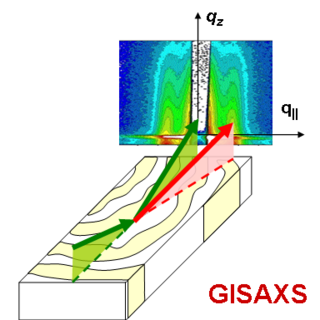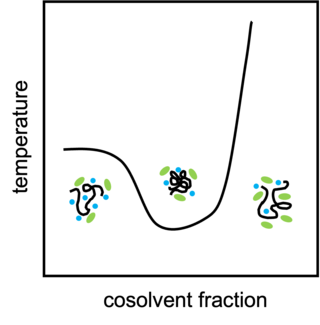Related Research Articles

A polymer is a substance or material consisting of very large molecules called macromolecules, composed of many repeating subunits. Due to their broad spectrum of properties, both synthetic and natural polymers play essential and ubiquitous roles in everyday life. Polymers range from familiar synthetic plastics such as polystyrene to natural biopolymers such as DNA and proteins that are fundamental to biological structure and function. Polymers, both natural and synthetic, are created via polymerization of many small molecules, known as monomers. Their consequently large molecular mass, relative to small molecule compounds, produces unique physical properties including toughness, high elasticity, viscoelasticity, and a tendency to form amorphous and semicrystalline structures rather than crystals.

A micelle or micella is an aggregate of surfactant amphipathic lipid molecules dispersed in a liquid, forming a colloidal suspension. A typical micelle in water forms an aggregate with the hydrophilic "head" regions in contact with surrounding solvent, sequestering the hydrophobic single-tail regions in the micelle centre.

In polymer chemistry, a copolymer is a polymer derived from more than one species of monomer. The polymerization of monomers into copolymers is called copolymerization. Copolymers obtained from the copolymerization of two monomer species are sometimes called bipolymers. Those obtained from three and four monomers are called terpolymers and quaterpolymers, respectively. Copolymers can be characterized by a variety of techniques such as NMR spectroscopy and size-exclusion chromatography to determine the molecular size, weight, properties, and composition of the material.
Small-angle X-ray scattering (SAXS) is a small-angle scattering technique by which nanoscale density differences in a sample can be quantified. This means that it can determine nanoparticle size distributions, resolve the size and shape of (monodisperse) macromolecules, determine pore sizes, characteristic distances of partially ordered materials, and much more. This is achieved by analyzing the elastic scattering behaviour of X-rays when travelling through the material, recording their scattering at small angles. It belongs to the family of small-angle scattering (SAS) techniques along with small-angle neutron scattering, and is typically done using hard X-rays with a wavelength of 0.07 – 0.2 nm.. Depending on the angular range in which a clear scattering signal can be recorded, SAXS is capable of delivering structural information of dimensions between 1 and 100 nm, and of repeat distances in partially ordered systems of up to 150 nm. USAXS can resolve even larger dimensions, as the smaller the recorded angle, the larger the object dimensions that are probed.
Poly(N-isopropylacrylamide) is a temperature-responsive polymer that was first synthesized in the 1950s. It can be synthesized from N-isopropylacrylamide which is commercially available. It is synthesized via free-radical polymerization and is readily functionalized making it useful in a variety of applications.

Temperature-responsive polymers or thermoresponsive polymers are polymers that exhibit drastic and discontinuous changes in their physical properties with temperature. The term is commonly used when the property concerned is solubility in a given solvent, but it may also be used when other properties are affected. Thermoresponsive polymers belong to the class of stimuli-responsive materials, in contrast to temperature-sensitive materials, which change their properties continuously with environmental conditions. In a stricter sense, thermoresponsive polymers display a miscibility gap in their temperature-composition diagram. Depending on whether the miscibility gap is found at high or low temperatures, either an upper critical solution temperature (UCST) or a lower critical solution temperature (LCST) exists.

Grazing-incidence small-angle scattering (GISAS) is a scattering technique used to study nanostructured surfaces and thin films. The scattered probe is either photons or neutrons. GISAS combines the accessible length scales of small-angle scattering and the surface sensitivity of grazing incidence diffraction (GID).

N,N′-Methylenebisacrylamide (MBAm or MBAA) is the organic compound with the formula CH2[NHC(O)CH=CH2]2. A colorlesss solid, this compound is a crosslinking agent in polyacrylamides, e.g., as used for SDS-PAGE.

Egbert (Bert) Willem Meijer is a Dutch organic chemist, known for his work in the fields of supramolecular chemistry, materials chemistry and polymer chemistry. Meijer, who is distinguished professor of Molecular Sciences at Eindhoven University of Technology (TU/e) and Academy Professor of the Royal Netherlands Academy of Arts and Sciences, is considered one of the founders of the field of supramolecular polymer chemistry. Meijer is a prolific author, sought-after academic lecturer and recipient of multiple awards in the fields of organic and polymer chemistry.
In polymer chemistry, chain walking (CW) or chain running or chain migration is a mechanism that operates during some alkene polymerization reactions. CW can be also considered as a specific case of intermolecular chain transfer. This reaction gives rise to branched and hyperbranched/dendritic hydrocarbon polymers. This process is also characterized by accurate control of polymer architecture and topology. The extent of CW, displayed in the number of branches formed and positions of branches on the polymers are controlled by the choice of a catalyst. The potential applications of polymers formed by this reaction are diverse, from drug delivery to phase transfer agents, nanomaterials, and catalysis.

A sequence-controlled polymer is a macromolecule, in which the sequence of monomers is controlled to some degree. This control can be absolute but not necessarily. In other words, a sequence-controlled polymer can be uniform or non-uniform (Ð>1). For example, an alternating copolymer synthesized by radical polymerization is a sequence-controlled polymer, even if it is also a non-uniform polymer, in which chains have different chain-lengths and slightly different compositions. A biopolymer with a perfectly-defined primary structure is also a sequence-controlled polymer. However, in the case of uniform macromolecules, the term sequence-defined polymer can also be used.

Timothy M. Swager is an American Scientist and the John D. MacArthur Professor of Chemistry at the Massachusetts Institute of Technology and the director of the Deshpande Center for Technological Innovation. His research is at the interface of chemistry and materials science, with specific interests in carbon nanomaterials, polymers, and liquid crystals. He is a member of the National Academy of Sciences and American Academy of Arts and Sciences.
Anne J. McNeil is an American chemist who currently works at the University of Michigan, where she holds the position of Arthur F. Thurnau Professor of Chemistry and Macromolecular Science and Engineering. In 2017, McNeil was named a fellow of the American Association for the Advancement of Science (AAAS).
Frank Steven Bates is an American chemical engineer and materials scientist. Bates is a Regent's Professor (2007–present), a Distinguished McKnight University Professor (1996–present), and department head (1999-2014) in the Department of Chemical Engineering and Materials Science at the University of Minnesota, where he has been a faculty member since 1989. Prior to his appointment at the University of Minnesota, Bates was a member of the technical staff at AT&T Bell Laboratories from 1982-1989.
Eilaf Egap is an Assistant Professor of Materials Science at Rice University. She works on imaging techniques and biomaterials for early diagnostics and drug delivery. She was a Massachusetts Institute of Technology MLK Visiting Scholar in 2011.

Amalie L. Frischknecht is an American theoretical polymer physicist at Sandia National Laboratories in Albuquerque, New Mexico. She was elected a fellow of the American Physical Society (APS) in 2012 for "her outstanding contributions to the theory of ionomers and nanocomposites including the development and application of density functional theory to polymers". Her research focuses on understanding the structure, phase behavior, and self-assembly of polymer systems, such as complex fluids polymer nanocomposites, lipid bilayer assemblies, and ionomers.
So-Jung Park 박소정(朴昭靜) is a Professor of Chemistry at Ewha Womans University, Republic of Korea. Her research considers the self-assembly of nanoparticles and functional molecules for biomedical and optoelectronic devices. She serves as Associate Editor of ACS Applied Materials & Interfaces and Nanoscale.
Ronald G. Larson is George G. Brown Professor of Chemical Engineering and Alfred H. White Distinguished University Professor at the University of Michigan, where he holds joint appointments in Macromolecular Science and Engineering, Biomedical Engineering, and Mechanical Engineering. He is internationally recognized for his research contributions to the fields of polymer physics and complex fluid rheology, especially in the development of theory and computational simulations. Notably, Larson and collaborators discovered new types of viscoelastic instabilities for polymer molecules and developed predictive theories for their flow behavior. He has written numerous scientific papers and two books on these subjects, including a 1998 textbook, “The Structure and Rheology of Complex Fluids”.

Polysulfobetaines are zwitterionic polymers that contain a positively charged quaternary ammonium and a negatively charged sulfonate group within one constitutional repeat unit. In recent years, polysulfobetaines have received increasing attention owing to their good biotolerance and ultralow-fouling behavior towards surfaces. These properties are mainly referred to a tightly bound hydration layer around each zwitterionic group, which effectively suppresses protein adsorption and thus, improves anti-fouling behavior. Therefore, polysulfobetaines have been typically employed as ultrafiltration membranes, blood-contacting devices, and drug delivery materials.

Cononsolvency is a phenomenon where two solvents that can typically readily dissolve a polymer, when mixed, at certain ratios of these two solvents, are no longer able to dissolve the polymer. This is in contrast to cosolvency where two solvents that are both poor at dissolving a material, but when the two poor solvents admixed, form a mixed solvent capable of dissolving the material.
References
- 1 2 3 4 5 6 7 "Department of Chemistry". Chem.umn.edu. 2013-06-14. Retrieved 2015-03-10.
- ↑ "University of Minnesota: Scholars Walk". Scholarswalk.umn.edu. 2015-01-23. Retrieved 2015-03-10.
- 1 2 "Chemistry Faculty Profile Timothy P. Lodge". University of Minnesota. Retrieved 7 November 2015.
- ↑ Lodge, Timothy P.; McLeish, Thomas C. B. (2000). "Self-Concentrations and Effective Glass Transition Temperatures in Polymer Blends". Macromolecules. American Chemical Society (ACS). 33 (14): 5278–5284. doi:10.1021/ma9921706. ISSN 0024-9297.
- ↑ Haley, Jeffrey C.; Lodge, Timothy P. (2004-06-01). "Failure of time-temperature superposition in dilute miscible polymer blends". Colloid & Polymer Science. Springer Science and Business Media LLC. 282 (8): 793–801. doi:10.1007/s00396-004-1092-5. ISSN 0303-402X.
- ↑ Savin, Daniel A.; Larson, Anne M.; Lodge, Timothy P. (2004). "Effect of composition on the width of the calorimetric glass transition in polymer-solvent and solvent-solvent mixtures". Journal of Polymer Science Part B: Polymer Physics. Wiley. 42 (7): 1155–1163. doi:10.1002/polb.10776. ISSN 0887-6266.
- 1 2 Hanley, Kenneth J.; Lodge, Timothy P. (1998). "Effect of dilution on a block copolymer in the complex phase window". Journal of Polymer Science Part B: Polymer Physics. Wiley. 36 (17): 3101–3113. doi:10.1002/(sici)1099-0488(199812)36:17<3101::aid-polb10>3.0.co;2-x. ISSN 0887-6266.
- ↑ Hanley, Kenneth J.; Lodge, Timothy P.; Huang, Ching-I (2000). "Phase Behavior of a Block Copolymer in Solvents of Varying Selectivity" (PDF). Macromolecules. American Chemical Society (ACS). 33 (16): 5918–5931. doi:10.1021/ma000318b. ISSN 0024-9297.
- ↑ Lodge, Timothy P.; Pudil, Bryant; Hanley, Kenneth J. (2002). "The Full Phase Behavior for Block Copolymers in Solvents of Varying Selectivity". Macromolecules. American Chemical Society (ACS). 35 (12): 4707–4717. doi:10.1021/ma0200975. ISSN 0024-9297.
- ↑ Bang, Joona; Lodge, Timothy P. (2003). "Mechanisms and Epitaxial Relationships between Close-Packed and BCC Lattices in Block Copolymer Solutions". The Journal of Physical Chemistry B. American Chemical Society (ACS). 107 (44): 12071–12081. doi:10.1021/jp035065d. ISSN 1520-6106.
- ↑ Lodge, Timothy P.; Bang, Joona; Park, Moon Jeong; Char, Kookheon (2004-04-06). "Origin of the Thermoreversible fcc-bcc Transition in Block Copolymer Solutions". Physical Review Letters. American Physical Society (APS). 92 (14): 145501. doi:10.1103/physrevlett.92.145501. hdl: 10371/5851 . ISSN 0031-9007. PMID 15089548.
- ↑ Park, Moon Jeong; Bang, Joona; Harada, Tamotsu; Char, Kookheon; Lodge, Timothy P. (2004). "Epitaxial Transitions among FCC, HCP, BCC, and Cylinder Phases in a Block Copolymer Solution". Macromolecules. American Chemical Society (ACS). 37 (24): 9064–9075. doi:10.1021/ma049285g. ISSN 0024-9297.
- ↑ Park, Moon Jeong; Char, Kookheon; Bang, Joona; Lodge, Timothy P. (2005). "Interplay between Cubic and Hexagonal Phases in Block Copolymer Solutions". Langmuir. American Chemical Society (ACS). 21 (4): 1403–1411. doi:10.1021/la048056k. ISSN 0743-7463. PMID 15697287.
- ↑ Wang, Chia-Ying; Lodge, Timothy P. (2002). "Kinetics and Mechanisms for the Cylinder-to-Gyroid Transition in a Block Copolymer Solution". Macromolecules. American Chemical Society (ACS). 35 (18): 6997–7006. doi:10.1021/ma0205212. ISSN 0024-9297.
- ↑ Bang, Joona; Lodge, Timothy P.; Wang, Xiaohui; Brinker, Kristin L.; Burghardt, Wesley R. (2002-10-31). "Thermoreversible, Epitaxial fcc↔bcc Transitions in Block Copolymer Solutions". Physical Review Letters. American Physical Society (APS). 89 (21): 215505. doi:10.1103/physrevlett.89.215505. ISSN 0031-9007. PMID 12443427.
- ↑ Li, Z.; Kesselman, E.; Talmon, Y.; Hillmyer, M. A.; Lodge, T. P. (2004-10-01). "Multicompartment Micelles from ABC Miktoarm Stars in Water". Science. American Association for the Advancement of Science (AAAS). 306 (5693): 98–101. doi:10.1126/science.1103350. ISSN 0036-8075. PMID 15459387.
- ↑ Li, Zhibo; Hillmyer, Marc A.; Lodge, Timothy P. (2006). "Morphologies of Multicompartment Micelles Formed by ABC Miktoarm Star Terpolymers". Langmuir. American Chemical Society (ACS). 22 (22): 9409–9417. doi:10.1021/la0620051. ISSN 0743-7463. PMID 17042562.
- ↑ Lodge, Timothy P.; Rasdal, April; Li, Zhibo; Hillmyer, Marc A. (2005). "Simultaneous, Segregated Storage of Two Agents in a Multicompartment Micelle". Journal of the American Chemical Society. American Chemical Society (ACS). 127 (50): 17608–17609. doi:10.1021/ja056841t. ISSN 0002-7863. PMID 16351082.
- ↑ Lodge, T. P. (2008-07-04). "Materials Science: A Unique Platform for Materials Design". Science. American Association for the Advancement of Science (AAAS). 321 (5885): 50–51. doi:10.1126/science.1159652. ISSN 0036-8075. PMID 18599764.
- ↑ He, Yiyong; Li, Zhibo; Simone, Peter; Lodge, Timothy P. (2006). "Self-Assembly of Block Copolymer Micelles in an Ionic Liquid". Journal of the American Chemical Society. American Chemical Society (ACS). 128 (8): 2745–2750. doi:10.1021/ja058091t. ISSN 0002-7863. PMID 16492063.
- ↑ He, Yiyong; Lodge, Timothy P. (2006). "The Micellar Shuttle: Thermoreversible, Intact Transfer of Block Copolymer Micelles between an Ionic Liquid and Water". Journal of the American Chemical Society. American Chemical Society (ACS). 128 (39): 12666–12667. doi:10.1021/ja0655587. ISSN 0002-7863. PMID 17002358.
- ↑ Gu, Yuanyan; Lodge, Timothy P. (2011-04-12). "Synthesis and Gas Separation Performance of Triblock Copolymer Ion Gels with a Polymerized Ionic Liquid Mid-Block". Macromolecules. American Chemical Society (ACS). 44 (7): 1732–1736. doi:10.1021/ma2001838. ISSN 0024-9297.
- ↑ Cho, J. H.; Lee, J.; He, Y.; Kim, B. S.; Lodge, T. P.; Frisbie, C. D. (2008-02-18). "High-Capacitance Ion Gel Gate Dielectrics with Faster Polarization Response Times for Organic Thin Film Transistors". Advanced Materials. Wiley. 20 (4): 686–690. doi:10.1002/adma.200701069. ISSN 0935-9648.
- ↑ Cho, Jeong Ho; Lee, Jiyoul; Xia, Yu; Kim, BongSoo; He, Yiyong; Renn, Michael J.; Lodge, Timothy P.; Daniel Frisbie, C. (2008-10-19). "Printable ion-gel gate dielectrics for low-voltage polymer thin-film transistors on plastic". Nature Materials. Springer Science and Business Media LLC. 7 (11): 900–906. doi:10.1038/nmat2291. ISSN 1476-1122. PMID 18931674.
- ↑ Lee, Jiyoul; Panzer, Matthew J.; He, Yiyong; Lodge, Timothy P.; Frisbie, C. Daniel (2007). "Ion Gel Gated Polymer Thin-Film Transistors". Journal of the American Chemical Society. American Chemical Society (ACS). 129 (15): 4532–4533. doi:10.1021/ja070875e. ISSN 0002-7863. PMID 17381097.
- ↑ He, Yiyong; Boswell, Paul G.; Bühlmann, Philippe; Lodge, Timothy P. (2007). "Ion Gels by Self-Assembly of a Triblock Copolymer in an Ionic Liquid†". The Journal of Physical Chemistry B. American Chemical Society (ACS). 111 (18): 4645–4652. doi:10.1021/jp064574n. ISSN 1520-6106. PMID 17474692.
- ↑ "Patents by Inventor Timothy P. Lodge". Justia. Retrieved 7 November 2015.
- 1 2 3 4 5 6 "Tim Lodge Regents Professor". Regents of the University of Minnesota. Retrieved 7 November 2015.
- ↑ "APS Fellow Archive". Aps.org. 2013-04-16. Retrieved 2015-03-10.
- ↑ "Arthur K. Dolittle Award - Polymeric Materials: Science and Engineering Division". Pmse.sites.acs.org. Retrieved 2015-03-10.
- ↑ "Prize Recipient". Aps.org. 2013-04-16. Retrieved 2015-03-10.
- ↑ "Chemistry International - Newsmagazine for IUPAC". Iupac.org. Retrieved 2015-03-10.
- ↑ "Editor Profile ACS Publications". ACS Publications. Retrieved 7 November 2015.
- ↑ "Fellows | AAAS MemberCentral". Membercentral.aaas.org. Archived from the original on 2014-07-27. Retrieved 2015-03-10.
- ↑ "American Chemical Society". Webapps.acs.org. Archived from the original on 2014-12-11. Retrieved 2015-03-10.
- ↑ "2010 ACS Fellows | August 2, 2010 Issue - Vol. 88 Issue 31 | Chemical & Engineering News". Cen.acs.org. 2010-08-02. Retrieved 2015-03-10.
- ↑ "Membership of the Academy of Distinguished Teachers" (PDF). Adt.umn.edu. Retrieved 2015-03-10.
- ↑ "2015 Herman F. Mark Award Winner: Timothy P. Lodge". American Chemical Society. Retrieved 7 November 2015.
- ↑ "Press Releases - American Academy of Arts & Sciences".
- ↑ "Lodge to lead Materials Research Science and Engineering Center (MRSEC) : College of Science & Engineering : University of Minnesota, Twin Cities". Cse.umn.edu. Archived from the original on 2015-04-02. Retrieved 2015-03-10.